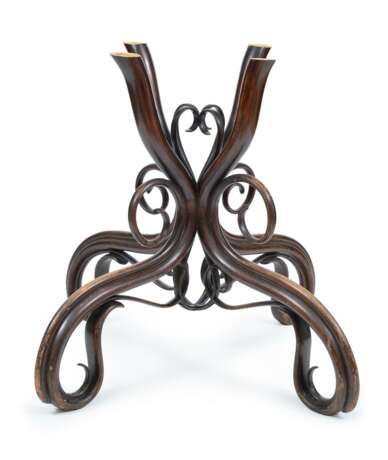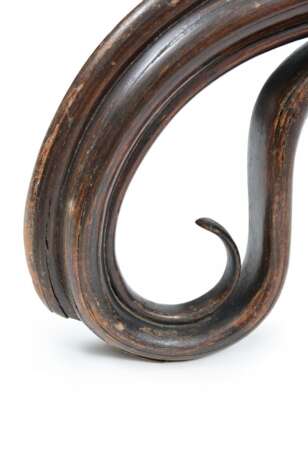ID 151278
Lot 6 | Salontisch Nr. 5 mit quadratischen Fuß
Estimate value
€ 2 400 – 3 000
Buchenholz, massiv gebogen und verleimt. 69x62cm.
Die klassischen Tische wurden vermutlich schon ab Mitte der 1850er Jahre hergestellt. Mittlerweile sind einige in der Technik massiv gebogener Leisten, die anschließend verleimt wurden, bekannt geworden. In einem Brief von Franz Thonet vom 10. Oktober 1861 bestellt er "je zwei Tischfüße No. 2, 3, 4 und 5". Das Sortiment war also zu Anfang der 1860er Jahre bereits relativ groß. Wie wir aus einem früheren Brief von Franz von Wien aus nach Koritschan vom 16. Februar 1861 erfahren, bestellt er u.a. "Tischgestelle für runde und für längliche Platten". Dies gab zuerst einige Rätsel auf, bis diese beiden Untergestelle eines Tisches Modell Nr. 5 gefunden wurden, die einmal einen quadratischen, dann aber auch einen rechteckigen Fuß haben. Die passenden Platten müssen entsprechend oval oder rund gewesen sein. Legt man eine ovale Platte auf einen quadratischen oder eine runde auf einen rechteckigen Fuß, so bemerkt man leicht, dass dies formal nicht stimmig ist. Auf allen Plakaten und in den Katalogen wurde später nur die ovale Platte, geschweift, mit rechteckigem Fuß angeboten.
Die beiden Untergestelle sind vollständig in der Technik des massiven Biegens der Einzelteile mit anschließender Verleimung des gesamten Bauteils hergestellt. Die Querschnitte der tragenden Teile des Tischfußes sind oval und betragen an der stärksten Stelle direkt unter der Tischplatte 51x47 mm. Der Stab selbst besteht aus 5 Lamellen, von denen eine jede eine Stärke von 12mm hat. Im äußeren Bereich der unteren Schlaufe beträgt die Breite zwar immer noch 45mm, die Stärke des Stabes ist jedoch auf 22mm reduziert bei einer Lamellenstärke von 4 bis 5mm. Alle anderen Teile sind jeweils 3 und 4 schichtig.
Obwohl man ab etwa 1860 auf das Biegen von vollständig massiven Hölzern umstellte, wurden Tische vermutlich noch länger als 1860 in dieser Technik hergestellt. Die fortschrittlichste Technik - das vollständige Massivbiegen - sollte vor allem bei den Artikeln angewandt werden, nach denen die größte Nachfrage bestand
| Address of auction |
VAN HAM Kunstauktionen GmbH Hitzelerstr. 2 50968 Köln Germany | ||||||||||||||
|---|---|---|---|---|---|---|---|---|---|---|---|---|---|---|---|
| Preview |
| ||||||||||||||
| Phone | +49 221 92586215 | ||||||||||||||
| Fax | +49 221 92 58 62 4 | ||||||||||||||
| Buyer Premium | 32% | ||||||||||||||
| Conditions of purchase | Conditions of purchase | ||||||||||||||
| Business hours | Business hours
|




